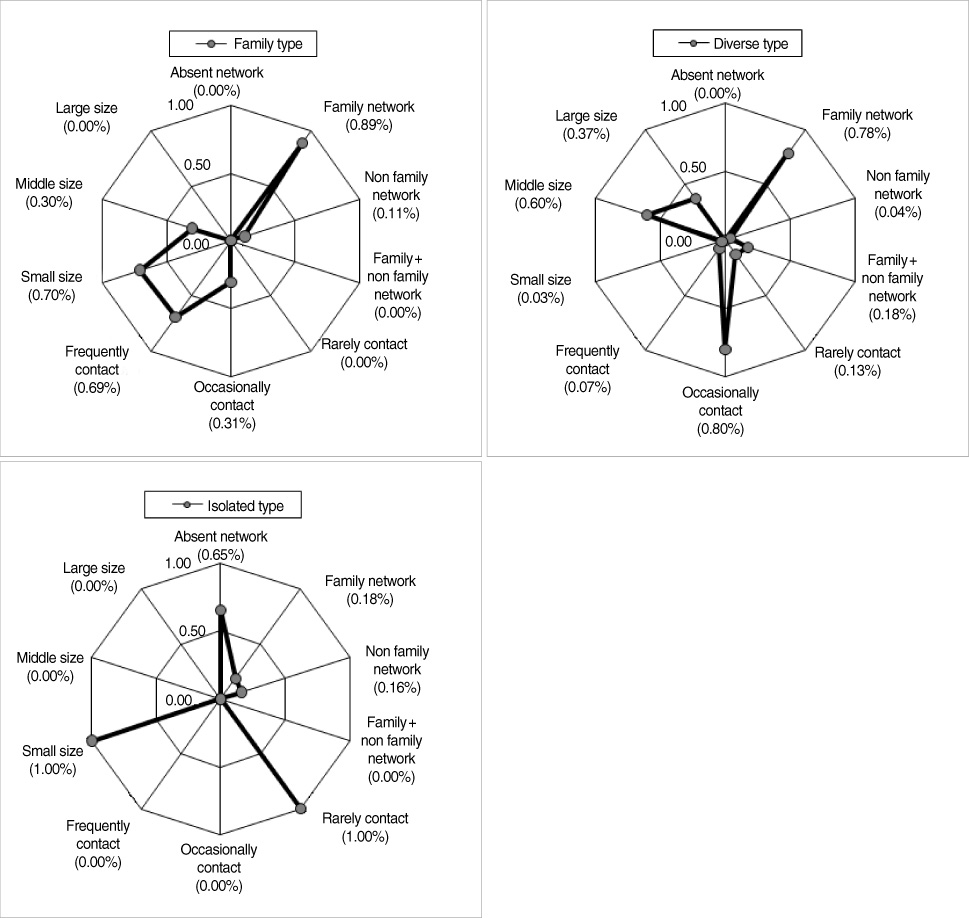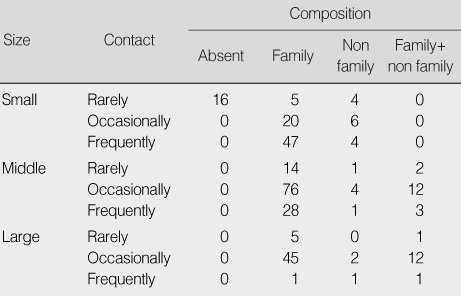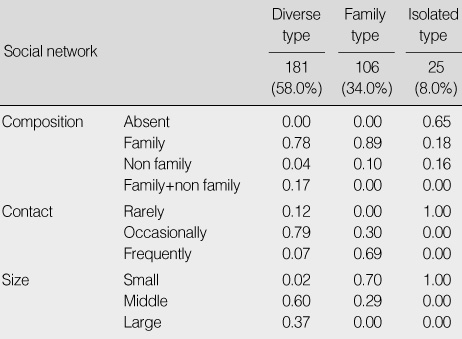Articles
- Page Path
- HOME > J Korean Acad Nurs > Volume 40(1); 2010 > Article
-
Original Article
- Correlation of Social Network Types on Health Status of Korean Elders
- Eui-Young Cheon
-
Journal of Korean Academy of Nursing 2010;40(1):88-98.
DOI: https://doi.org/10.4040/jkan.2010.40.1.88
Published online: February 28, 2010
Full-time Lecturer, Department of Nursing, Suwon Women's College, Suwon, Korea.
- Address reprint requests to: Cheon, Eui-Young. Department of Nursing, 62 Suwonyeodae-gil, Kwonseon-gu, Suwon 441-748, Korea. Tel: 82-31-290-8114, Fax: 82-31-290-8142, astra20@swc.ac.kr
Copyright © 2010 Korean Society of Nursing Science
Abstract
-
Purpose
- The purpose of this study was to identify the social network types of elders and to identify differences among latent classes by social network.
-
Methods
- The data of 312 elders used in this study were collected from health, welfare, and other facilities and from elders living in the community. The interviews were conducted from July 16 to September 30, 2007 using a standard, structured questionnaire. Descriptive statistics, one way ANOVA with the SPSS 15.0 program and latent class analysis using Maximum Likelihood Latent Structure Analysis (MLLSA) program were used to analyze the data.
-
Results
- Using latent class analysis, social network types among older adults were identified as diverse for 58.0% of the sample, as family for 34.0%, and as isolated for 8.0%. The health status of respondents differed significantly by network type. Elders in diverse networks had significantly higher health status and elders in isolated networks had significantly lower physical health status on average than those in all other networks.
-
Conclusion
- The results of this study suggest that these network types have important practical implications for health status of elders. Social service programs should focus on different groups based on social network type and promote social support and social integration.
- 1. Adams RG, Blieszner R. Aging well with friends and family. The American Behavioral Scientist. 1995;39:209–224.ArticlePDF
- 2. Antonucci TC. Birren JE. Social relations: An examination of social networks, social support, and sense of control. In: Handbook of the psychology of aging. 2001;San Diego, CA, Academic Press.
- 3. Antonucci TC, Akiyama H. Social networks in adult life and a preliminary examination of the convoy model. Journal of Gerontology. 1987;42:519–527.ArticlePubMed
- 4. Berkman LF, Kawachi I. Social epidemiology. 2000;New York, NY, Oxford University Press.
- 5. Bott E. Family and social network. 1971;New York, NY, The Free Press.
- 6. Bowling A, Browne PD. Social networks, health, and emotional well-being among the oldest old in London. Journal of Gerontology. 1991;46:20–32.
- 7. Bukov A, Maas I, Lampert T. Social participation in very old age: Cross-sectional and longitudinal findings from BASE. Journal of Gerontology: Psychological Sciences. 2002;57:510–517.
- 8. Chatters LM, Taylor RJ, Jackson JS. Size and composition of the informal helper networks of elderly blacks. Journal of Gerontology. 1985;40:605–614.ArticlePubMed
- 9. Chung KH. The social networks of the elderly. Journal of the Korean Gerontological Society. 1995;15:52–68.
- 10. DePertuis LL, Aldwin CM, Bosse R. Does the source of support matter for different health outcomes? Findings fromthe normative aging study. Journal of Aging and Health. 2001;13:494–510.PubMed
- 11. Dunkle RE, Roberts BL, Haug MR. The oldest old in everyday life: Self perception, coping with change, and stress. 2001;New York, NY, Springer.
- 12. Fiori KL, Antonucci TC, Cortina KS. Social network typologies and mental health among older adults. The Journal of Gerontology. 2006;61:25–32.
- 13. Granovetter M. The strength of weak ties. American Journal of Sociology. 1973;78:1360–1380.Article
- 14. Hwang MY, Lee JS. Informal support network typology of the urban low-income elderlies. Korean Journal of Family Social Work. 1998;2:169–193.
- 15. Kahn RL. Riley MW. Aging and social support. In: Aging from birth to death: An interdisciplinary perspective. 1979;Boulder, CO, Westview.
- 16. Kim YH. Social network analysis. 2003;Seoul, Parkyoungsa.
- 17. Korea Institute for Health and Social Affairs. 2004 A study on living condition and welfare in elderly. 2005;Seoul, Author.
- 18. Krause N, Liang J, Keith V. Personality, social support, and psychological distress in later life. Psychology & Aging. 1990;5:315–326.Article
- 19. Litwak E, Szelenyi I. Primary group structures and their functions: Kin, neighbors, and friends. American Sociological Review. 1969;34:465–481.Article
- 20. Litwin H. Support network types and health service utilization. Research on Aging. 1997;19:274–299.
- 21. Litwin H. Social network type and morale in old age. The Gerontologist. 2001;41:516–524.ArticlePubMed
- 22. Litwin H, Landau R. Social network type and socialsupport among the old-old. Journal of Aging Studies. 2000;14:213–228.Article
- 23. McCutcheon AL. Latent class analysis. 1987;Beverly Hills, CA, Sage.
- 24. Mitchell JC. Mitchell JC. The concept and use of social networks. In: Social networks in urban situation: Analyses of personal relationships in Central African towns. 1969;Manchester, Manchester University Press.
- 25. Russell DW, Cutrona CE. Social support, stress, and depressive symptoms among the elderly: Test of a process model. Psychology & Aging. 1991;6:190–201.Article
- 26. Sugisawa H, Shibata H, Hougham GW, Sugihara Y, Liang J. The impact of social ties on depressive symptoms in U S. and Japanese elderly. Journal of Social Issues. 2002;58:785–804.Article
- 27. Takahashi K, Tamura J, Tokoro M. Patterns of social relationships and psychological well-being among the elderly. International Journal of Behavioral Development. 1997;21:417–430.ArticlePDF
- 28. van Tilburg T. Losing and gaining in old age: Changes in personal network size and social support in a four-year longitudinal study. Journal of Gerontology: Social Scienc. s. 1998;53:313–323.
- 29. Ware JE Jr, Kosinski M, Bjorner JB, Turner-Bowker DM, Gandek B, Maruish ME. User's manual for the SF-36v2 health survey. 2007;2nd ed. Lincoln, RI, QualityMetric Incorporated.
- 30. Wenger GC. Social networks and prediction of elderly people at risk. Aging & Mental Health. 1997;1:311–320.Article
- 31. Won HJ. A study on the social network types of housewives in urban nuclear families. 1997;Seoul, Seoul National University. Unpublished doctoral dissertation.
- 32. Yee J, Kang SJ, Phang H, Lee MJ, Park KS, Eun KS, et al. Advanced Statistical Analysis Methods in Social Science. 2007;Seoul, Seoul National University Press.
- 33. Youm Y. Social network effects on breast cancer patients (Grant #5 P50CA106743). 2003;Chicago, IL, University of ILLinois at Chicago, Center for Population Health and Health Disparities.
REFERENCES
Figure & Data
REFERENCES
Citations

- Social Network Analysis of Self‐Management Behavior Among Older Adults With Diabetes
Geumbo Ko, Youngshin Song
Public Health Nursing.2025; 42(3): 1147. CrossRef - Cognitive Frailty in Older Adults Living in Rural Areas: Sex-Specific Determinants
Ah Ram Jang, Hae Sagong
Journal of Population Ageing.2025;[Epub] CrossRef - Social Network Contact Frequency and Life Satisfaction of the Elderly: Focusing on the Moderating Effect of Digital Capabilities
Eun Hye Kim
Human Ecology Research.2024; 62(2): 217. CrossRef - Always alone? Network transitions among detached older Europeans and their effects
Howard Litwin, Michal Levinsky
Ageing and Society.2021; 41(10): 2299. CrossRef - Multilevel Factors Associated with Frailty among the Rural Elderly in Korea Based on the Ecological Model
Ah Ram Jang, Ju Young Yoon
International Journal of Environmental Research and Public Health.2021; 18(8): 4146. CrossRef - The Role of Social Networks on Depressive Symptoms: A Comparison of Older Koreans in Three Geographic Areas
Nan Sook Park, Yuri Jang, David A. Chiriboga, Soondool Chung
The International Journal of Aging and Human Development.2021; 92(3): 364. CrossRef - Association between social network structure and physical activity in middle-aged Korean adults
So Mi Jemma Cho, Hokyou Lee, Jee-Seon Shim, Yoosik Youm, Sun Jae Jung, Dae Jung Kim, Hyeon Chang Kim
Social Science & Medicine.2021; 282: 114112. CrossRef - A Typology of Social Networks and Its Relationship to Psychological Well-Being in Korean Adults
Nan Sook Park, David A. Chiriboga, Soondool Chung
The International Journal of Aging and Human Development.2020; 90(3): 211. CrossRef - Social network types, health, and well-being of older Asian Americans
Nan Sook Park, Yuri Jang, David A. Chiriboga, Soondool Chung
Aging & Mental Health.2019; 23(11): 1569. CrossRef - A Urban-Rural Differences of Social Environment
Junga Lee
Journal of Digital Contents Society.2019; 20(4): 817. CrossRef - Social support networks in Chinese older adults: health outcomes and health related behaviors: a path analysis
Qi Xiao, Meiliyang Wu, Tieying Zeng
Aging & Mental Health.2019; 23(10): 1382. CrossRef - Social Support Networks and Quality of Life of Rural Men in a Context of Marriage Squeeze in China
Sasa Wang, Xueyan Yang, Isabelle Attané
American Journal of Men's Health.2018; 12(4): 706. CrossRef - Associations of a social network typology with physical and mental health risks among older adults in South Korea
N.S. Park, Y. Jang, B.S. Lee, D.A. Chiriboga, S. Chang, S.Y. Kim
Aging & Mental Health.2018; 22(5): 631. CrossRef - Social Network Types, Health, and Health-Care Use Among South Korean Older Adults
Sojung Park, Ji Young Kang, Letha A. Chadiha
Research on Aging.2018; 40(2): 131. CrossRef - A Preliminary Study for the Development and Validation of an Instrument to Measure Social Environment Influencing Health
Junga Lee
Journal of Digital Contents Society.2018; 19(11): 2093. CrossRef - Social network types among older Korean adults: Associations with subjective health
Sung Yun Sohn, Won-tak Joo, Woo Jung Kim, Se Joo Kim, Yoosik Youm, Hyeon Chang Kim, Yeong-Ran Park, Eun Lee
Social Science & Medicine.2017; 173: 88. CrossRef - Risk Factors for Social Isolation in Older Korean Americans
Yuri Jang, Nan Sook Park, David A. Chiriboga, Hyunwoo Yoon, Jisook Ko, Juyoung Lee, Miyong T. Kim
Journal of Aging and Health.2016; 28(1): 3. CrossRef - Longitudinal changes in social networks, health and wellbeing among older Koreans
BORIN KIM, SOJUNG PARK, TONI C. ANTONUCCI
Ageing and Society.2016; 36(9): 1915. CrossRef - An Empirical Typology of Social Networks and Its Association With Physical and Mental Health: A Study With Older Korean Immigrants
N. S. Park, Y. Jang, B. S. Lee, J. E. Ko, W. E. Haley, D. A. Chiriboga
The Journals of Gerontology Series B: Psychological Sciences and Social Sciences.2015; 70(1): 67. CrossRef - Prediction of Quality of Life among the Elderly at Care Facilities for the Elderly according to Health States, Physical and Cognitive Functions, and Social Supports-Focused on D Metropolitan City
Jong-Im Kim
Journal of the Korea Academia-Industrial cooperation Society.2015; 16(7): 4656. CrossRef - Confidant Network Types and Well-Being Among Older Europeans
H. Litwin, K. J. Stoeckel
The Gerontologist.2014; 54(5): 762. CrossRef - Social network properties and self-rated health in later life: comparisons from the Korean social life, health, and aging project and the national social life, health and aging project
Yoosik Youm, Edward O Laumann, Kenneth F Ferraro, Linda J Waite, Hyeon Chang Kim, Yeong-Ran Park, Sang Hui Chu, Won-tak Joo, Jin A Lee
BMC Geriatrics.2014;[Epub] CrossRef - Social Activities and Health of Korean Elderly Women by Age Groups
Ju-hyun Kim, Minhye Kim, Joongbaeck Kim
Educational Gerontology.2013; 39(9): 640. CrossRef - Social network type and health-related behaviors: Evidence from an American national survey
Sharon Shiovitz-Ezra, Howard Litwin
Social Science & Medicine.2012; 75(5): 901. CrossRef - Social Network Type and Subjective Well-being in a National Sample of Older Americans
H. Litwin, S. Shiovitz-Ezra
The Gerontologist.2011; 51(3): 379. CrossRef - The Association of Background and Network Type Among Older Americans
Howard Litwin, Sharon Shiovitz-Ezra
Research on Aging.2011; 33(6): 735. CrossRef

Figure 1
Frequency of Social Network Variables for Latent Class Analysis (N=312)
Confirmatory Latent Class Analysis (N=312)
Characteristics of Social Network Type (N=312)
Difference of Health Status by Social Network Type (N=312)
For multiple comparisons, no difference between same letter; a, b, c.
Correlations between Social Network Type and Health Status (N=312)
HS=Health status; PCS=Physical component summary; PF=Physical functioning; RP=Role-physical; BP=Bodily pain; GH=General health; MCS=Mental component summary; V=Vitality; SF=Social functioning; RE=Role-emotional; MH=Mental health.
For multiple comparisons, no difference between same letter; a, b, c.
HS=Health status; PCS=Physical component summary; PF=Physical functioning; RP=Role-physical; BP=Bodily pain; GH=General health; MCS=Mental component summary; V=Vitality; SF=Social functioning; RE=Role-emotional; MH=Mental health.
 KSNS
KSNS
 E-SUBMISSION
E-SUBMISSION






 Cite
Cite

